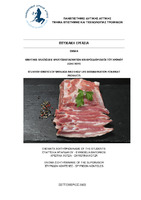| dc.contributor.advisor | Κοντελές, Σπυρίδων | |
| dc.contributor.author | Μπαρδάκου, Ευαγγελία | |
| dc.contributor.author | Χότζα, Χριστίνα | |
| dc.date.accessioned | 2023-10-23T11:18:19Z | |
| dc.date.available | 2023-10-23T11:18:19Z | |
| dc.date.issued | 2023-09-29 | |
| dc.identifier.uri | https://polynoe.lib.uniwa.gr/xmlui/handle/11400/5458 | |
| dc.identifier.uri | http://dx.doi.org/10.26265/polynoe-5295 | |
| dc.description.abstract | Γενικά, η επίδραση των περιβαλλοντικών παραγόντων, η σύνθεση του τροφίμου και οι συνθήκες αποθήκευσης παίζουν καθοριστικό ρόλο στην κινητική αλλοίωσης του. Η κινητική της μικροβιακής αλλοίωσης εστιάζεται στον ρυθμό με τον οποίο ομάδες ή μεμονωμένοι μικροοργανισμοί αλλοίωσης αναπτύσσονται και υποβαθμίζουν τα τρόφιμα. Αυτές οι κινητικές συχνά ακολουθούν μια σιγμοειδή καμπύλη, που χαρακτηρίζεται από την φάση προσαρμογής, την φάση λογαριθμικής ανάπτυξης και την στατική φάση. Παράμετροι όπως ο ειδικός ρυθμός ανάπτυξης (μ) και ο χρόνος προσαρμογής (λ) ποσοτικοποιούνται χρησιμοποιώντας μαθηματικά μοντέλα όπως το μοντέλο Baranyi. Σε αυτή τη μελέτη, εμπορικά παρασκευασμένο μπέικον σε φέτες και συσκευασμένο σε κενό διατηρήθηκε σε τρεις ισοθερμικές θερμοκρασίες 5, 10 και 15°C. Σε τακτά χρονικά διαστήματα, λήφθηκαν δείγματα και αναλύθηκαν μικροβιολογικά για τις ακόλουθες ομάδες μικροοργανισμών, Aerobic Plate Count, Lactic Acid Bacteria, Carnobacterium spp. και Clostridium spp. Σε όλα τα δείγματα και τις ομάδες μικροοργανισμών που παρακολουθήθηκαν το αρχικό μικροβιακό φορτίο ήταν υψηλό, της τάξης των 10^4 -10^6 cfu/g. Ως ομάδα μικροοργανισμών δείκτη αλλοίωσης, επιλέχθηκαν βακτήρια Γαλακτικού Οξέος και χρησιμοποιώντας την διαδικτυακή βάση δεδομένων Combase και την κατάλληλη εξίσωση προσέγγισης - με βάση το μοντέλο Baranyi - υπολογίστηκε η διάρκεια ζωής του μπέικον, υπό ισοθερμικές συνθήκες. Συγκεκριμένα, λήφθηκε διάρκεια ζωής 9 ημερών για τα δείγματα μπέικον που αποθηκεύτηκαν στους 5°C και 4 ημέρες για τα
δείγματα που αποθηκεύτηκαν στους 10°C. | el |
| dc.format.extent | 67 | el |
| dc.language.iso | el | el |
| dc.publisher | Πανεπιστήμιο Δυτικής Αττικής | el |
| dc.rights | Αναφορά Δημιουργού - Μη Εμπορική Χρήση - Παρόμοια Διανομή 4.0 Διεθνές | * |
| dc.rights | Attribution-NonCommercial-NoDerivatives 4.0 Διεθνές | * |
| dc.rights | Attribution-NonCommercial-NoDerivatives 4.0 Διεθνές | * |
| dc.rights.uri | http://creativecommons.org/licenses/by-nc-nd/4.0/ | * |
| dc.subject | Κρεατοσκευάσματα | el |
| dc.subject | Μπέικον | el |
| dc.subject | Συσκευασία υπό κενό | el |
| dc.subject | Αλλοίωση | el |
| dc.subject | Ολική μεσόφιλη χλωρίδα | el |
| dc.subject | Οξυγαλακτικά βακτήρια | el |
| dc.subject | Carnobacterium spp. | el |
| dc.subject | Clostridium spp. | el |
| dc.subject | ComeBase | el |
| dc.title | Κινητικές αλλοιώσεις κρεατοσκευασμάτων και προσδιορισμός του χρόνου ζωής τους | el |
| dc.title.alternative | Study of kinetics of spoilage and shelf life determination for meat products | el |
| dc.type | Πτυχιακή εργασία | el |
| dc.contributor.committee | Στρατή, Ειρήνη | |
| dc.contributor.committee | Batrinou, Anthimia | |
| dc.contributor.faculty | Σχολή Επιστημών Τροφίμων | el |
| dc.contributor.department | Τμήμα Επιστήμης και Τεχνολογίας Τροφίμων | el |
| dc.description.abstracttranslated | In general, the effect of environmental factors, product composition and storage conditions play a decisive role in the spoilage kinetics of a product. Microbial spoilage kinetics focus on the rate at which groups or individual spoilage microorganisms grow and degrade food products. These kinetics often follow a sigmoidal curve, characterized by lag, log, and stationary phases. Parameters such as specific growth rate (µ) and lag time (λ) are quantified using mathematical models like the Baranyi model Spoilage. In this study commercially prepared sliced and vacuum-packed bacon was preserved at three isothermal temperatures of 5, 10 and 15°C. At regular intervals, samples were taken and microbiologically analyzed for the following groups of microorganisms, Aerobic Plate Count, Lactic Acid Bacteria, Carnobacterium spp. and Clostridium spp. In all samples and groups of microorganisms monitored the initial microbial load was high, in the order of 10^4 - 10^6 cfu/g. As a group of spoilage indicator microorganisms, Lactic Acid Bacteria were selected and using the Combase online database and the appropriate approximation
equation, - based on the Baranyi model - the shelf life of bacon was calculated, under isothermal conditions. In particular, a shelf life of 9 days was obtained for the bacon samples stored at 5°C and 4 days for the samples stored at 10°C. | el |



